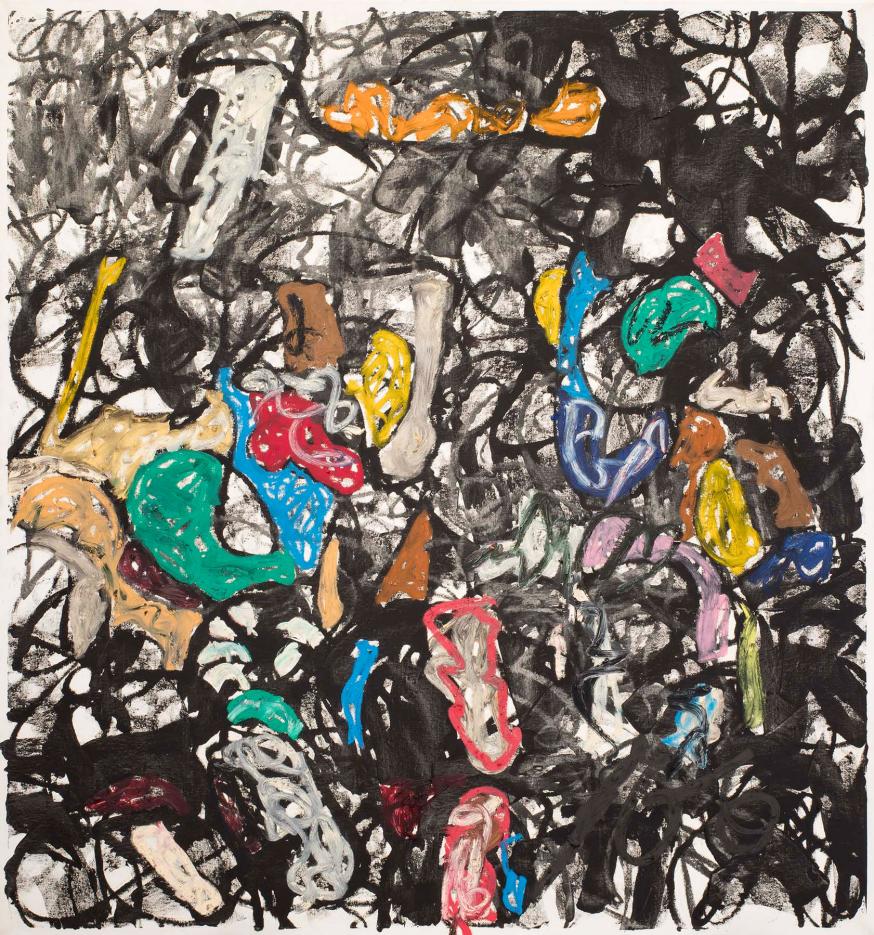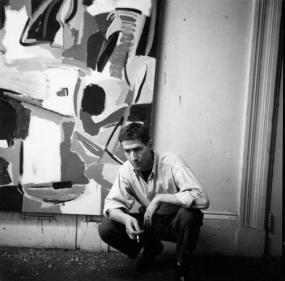Michael Goldberg
1924–2007


Michael Goldberg in his studio, c.1950; Photographer unknown, Courtesy of the Estate of Michael Goldberg
All artworks displayed above are currently available. To inquire about additional works available by this artist, please contact the gallery.
Biography
I find that the dictates of my vision are something I can’t control. For me, the concept of abstract painting is still the primary visual challenge of our time. It might get harder and harder to make an abstract image that’s believable, but I think that just makes the challenge greater.
A leading figure of the second generation of abstract expressionists who came into artistic maturity at the height of the New York School’s ascendancy, Michael Goldberg (1924–2007) was born Sylvan Irwin Goldberg in 1924. Growing up in the Bronx, Goldberg was a precocious student who read Lautréamont, Baudelaire, and Nerval; after finishing high school at the age of fourteen, he enrolled in City College and began taking Saturday classes at the Art Students League. Goldberg soon found New York’s jazz scene to be a far more stimulating environment than City College and began skipping classes to frequent the Harlem clubs near campus. Jazz would become a lifelong passion for the artist as well as a formative influence on his compositional approach. From 1940 to 1942 he studied at Hans Hofmann’s recently founded school, where an array of modernist luminaries such as Franz Kline and Jackson Pollock would often drop in.
Goldberg’s artistic development was interrupted in 1943 when he decided to enlist in the army; he ultimately became a master sergeant, serving in North Africa and the China-Burma-India Theater. After receiving a Purple Heart and Bronze Star for his service, Goldberg was honorably discharged and traveled to Venezuela to work in the oil fields there. In 1946, he returned to New York, where he resumed his studies at Hofmann’s school and the Art Students League. Goldberg had been wounded three times during combat, leaving his arm partially paralyzed; on the advice of his physical therapist at the Veteran’s Association, he began taking stone carving and other classes taught by sculptor José de Creeft at the Art Students League. Not only did the stone carving classes successfully rehabilitate him physically, but de Creeft’s classes also exposed Goldberg to the collage techniques that would later become an essential aspect of his painting practice. In these years, Goldberg frequented the legendary Cedar Bar, a popular watering hole for many avant-garde artists living in lower Manhattan; there he befriended many of the New York School painters, including Jackson Pollock, Franz Kline, and Mark Rothko. By the end of the 1950s, Goldberg had taken over Rothko’s studio at 222 Bowery. Golberg was also active in the Eighth Street Club, a discussion group founded by downtown artists working in abstraction in 1949.
In 1951, Goldberg’s work made its public debut when he was included in the landmark Ninth Street Show, co-organized by Leo Castelli, Conrad Marca-Relli, and the Eighth Street Club; open for three weeks at a temporary space at 60 East 9th Street, the exhibition also featured Hofmann, Pollock, Willem de Kooning, Joan Mitchell, Helen Frankenthaler, and many others. In 1953, Tibor de Nagy Gallery gave Goldberg his first solo exhibition, and three years later Goldberg’s friendship with the painter Norman Bluhm led to art collector Walter P. Chrysler, Jr.’s acquisition of seventeen paintings from Goldberg’s studio. Martha Jackson Gallery began representing him shortly thereafter. In 1960, he collaborated with his close friend, the poet and curator Frank O’Hara, on a book of poems and prints titled Odes. He spent the following year in Berkeley, CA, working as a visiting artist for the University of California.
In 1969, he met artist Lynn Umlauf, with whom he would remain partnered for the rest of his life; they married ten years later. Both Goldberg and Umlauf cultivated long and impactful teaching careers at the School of Visual Arts, and Goldberg remained on staff there until his death. Beginning in 1980, Goldberg and Umlauf spent five months of the year in Tuscany, during which Goldberg would frequently drive to Siena to enjoy the city’s 14th-century frescoes. These trips were of vital importance to Goldberg’s work, as he conceived of painting as a dialogue between artists of the past, artists of the present, and the viewers who engaged with their work. An enthusiastic conversationalist with a rowdy sense of humor, Goldberg welcomed anyone and everyone to share his boundless passion for painting through the study and discussion of art.
Goldberg died of a heart attack on December 31, 2007, amid a resurgent interest in his oeuvre. Since his death, his work has been exhibited in numerous solo and group exhibitions, including Dorothy & Herbert Vogel Collection – Fifty Works for Fifty States, National Gallery of Art, Washington DC (2008); Rothko to Richter: Mark-Making in Abstract Painting from the Collection of Preston H. Haskell, Princeton University Art Museum, Princeton, NJ (2013); Why Draw? 500 Years of Drawings and Watercolors at Bowdoin College, Bowdoin College Museum of Art, Brunswick, ME (2017); and Abstract Expressionism: A Social Revolution, Selections from the Haskell Collection, Tampa Museum of Art, Tampa (2019). Multiple notable retrospective exhibitions of Goldberg’s work have been organized since his death, including Ode to Michael Goldberg: Selective Thievery and the Practice of Looking at the Anderson Gallery, University at Buffalo, State University of New York in Buffalo, NY (2008); Perpetual Motion: Michael Goldberg at the University Art Museum, California State University, Long Beach, CA (2010); and Abstraction over Time: The Paintings of Michael Goldberg at the Museum of Contemporary Art in Jacksonville, Florida (2013). Curated by Marcelle Polednik, Abstraction Over Time was accompanied by a fully illustrated catalogue with essays by Polednik, Jeremy Gilbert-Rolfe, Karen Wilkin and a statement by Irving Sandler. Goldberg’s work has had a consistent presence in Michael Rosenfeld Gallery’s programming since 2011. In 2015, the gallery mounted its first solo exhibition for the artist, Michael Goldberg: Making His Mark, Paintings and Drawings: 1985-2005, which was followed by another solo show in 2018, Michael Goldberg: End to End, The 1950s & 2000s.
Michael Goldberg’s work is in numerous museum collections worldwide including the Academy Art Museum, Easton, MD; Albright-Knox Art Gallery, Buffalo, NY; American University Museum, Katzen Arts Center, Washington, DC; Arkansas Art Center, Little Rock, AR; Art Institute of Chicago, Chicago, IL; Baltimore Museum of Art, Baltimore, MD; Berkeley Art Museum and Pacific Film Archive, University of California, Berkeley, CA; Birmingham Museum of Art, Birmingham, AL; Blanton Museum of Art, University of Texas, Austin, TX; Boise Art Museum, Boise, ID; Brooklyn Museum, Brooklyn, NY; Carolyn Campagna Kleefeld Contemporary Art Museum, California State University, Long Beach, CA; Chrysler Museum of Art, Norfolk, VA; Cleveland Museum of Art, Cleveland, OH; Colorado Springs Fine Arts Center, Colorado Springs, CO; David Owsley Museum of Art, Ball State University, Muncie, IN; The Dayton Art Institute, Dayton, OH; DeCordova Museum and Sculpture Park, Lincoln, MA; Delaware Art Museum, Wilmington, DE; Fogg Museum, Harvard Art Museums, Harvard University, Cambridge, MA; Greenville County Museum of Art, Greenville, SC; High Museum of Art, Atlanta, GA; Herbert F. Johnson Museum of Art, Cornell University, Ithaca, NY; Hirshhorn Museum and Sculpture Garden, Washington, DC; Indianapolis Museum of Art, Newfields, A Place for Nature and the Arts, Indianapolis, IN; Jane Voorhees Zimmerli Art Museum, Rutgers University, New Brunswick, NJ; Joslyn Art Museum, Omaha, NE; Milwaukee Art Museum, Milwaukee, WI; Mississippi Museum of Art, Jackson, MS; Montana Historical Society, Helena, MT; The Morgan Library & Museum, New York, NY; Muscarelle Museum of Art, College of William and Mary, Williamsburg, VA; Museum of Contemporary Art, Los Angeles, CA; Museum of Fine Arts, Houston, TX; Museum of Fine Arts, St. Petersburg, FL; Museum of Modern Art, Jerusalem, Israel; The Museum of Modern Art, New York, NY; Museum of Modern Western Art, Tokyo, Japan; National Gallery of Art, Washington, DC; The New Orleans Museum of Art, New Orleans, LA; Pennsylvania Academy of the Fine Arts, Philadelphia, PA; Pérez Art Museum Miami, Miami, FL; Philadelphia Museum of Art, Philadelphia, PA; Phoenix Art Museum, Phoenix, AZ; Portland Museum of Art, Portland, ME; Princeton University Art Museum, Princeton University, Princeton, NJ; Provincetown Art Association and Museum, Provincetown, RI; Richard F. Brush Art Gallery, St. Lawrence University, Canton, NY; San Francisco Museum of Modern Art, San Francisco, CA; Seattle Art Museum, Seattle, WA; Sheldon Memorial Art Gallery, University of Nebraska, Lincoln, NE; Smithsonian American Art Museum, Washington, DC; Speed Art Museum, Louisville, KY; The Solomon R. Guggenheim Museum, New York, NY; Helen Foresman Spencer Museum of Art, University of Kansas, Lawrence, KS; UB Anderson Gallery, University of Buffalo, Buffalo, NY; University Museum of Contemporary Art, University of Massachusetts, Amherst, MA; University of Kentucky Art Museum, Lexington, KY; University of Michigan Museum of Art, Ann Arbor, MI; Vero Beach Museum of Art, Vero Beach, FL; Wadsworth Atheneum Museum of Art, Hartford CT; Walker Art Center, Minneapolis, MN; Frederick R. Weisman Art Museum, University of Minnesota, Minneapolis, MN; Whitney Museum of American Art, New York, NY; Yale University Art Gallery, Yale University, New Haven, CT; and the Yellowstone Art Museum, Billings, MT.
Michael Rosenfeld Gallery LLC represents the Estate of Michael Goldberg.
Gallery Exhibitions
Press
Publications

